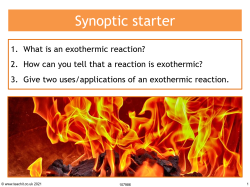Calculating the rate of a chemical reaction

This complete PowerPoint lesson includes a starter, lesson objectives and learning outcomes scaled by GCSE grade, as well as a useful summary of prior learning.
There are a number of worked examples to help students to understand the mean rate of reaction and the reaction rate at a specific time, followed by practice questions (and answers) to build students' confidence.
An example slide from the PowerPoint:
To work out the rate of reaction at a specific point – for example, after 4 seconds or after 20 seconds – you need to calculate the gradient of the graph at that point in time.
Important points:
1. The steeper the gradient, the faster the reaction is going (high rate of reaction).
2. The less steep the gradient, the more slowly the reaction is going (low rate of reaction).
3. If the graph is level/flat, the reaction has finished.
